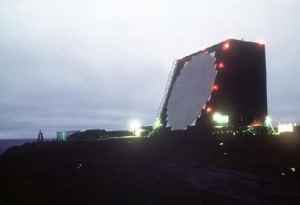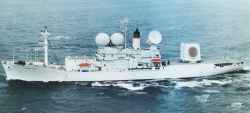AN/FPS-108 “Cobra Dane”
Description of the radar set, tactical-technical characteristics

Bild 1:
| Specifications | |
|---|---|
| frequency: | 1175 to 1375 MHz
L-Band |
| pulse repetition time (PRT): | |
| pulse repetition frequency (PRF): | |
| pulsewidth (τ): | 1 or 2 ms |
| receive time: | |
| dead time: | |
| peak power: | 16 MW |
| average power: | 1 MW |
| instrumented range: | 46,000 km |
| range resolution: | |
| accuracy: | |
| beamwidth: | 0.6˚ |
| hits per scan: | |
| antenna rotation: | |
| MTBCF: | |
| MTTR: | |
AN/FPS-108 “Cobra Dane”
Cobra Dane is a large, phased-array radar at Shemya Air Force Base in the Aleutian Islands under USAF Program 633A. Its purpose is the detection and tracking of ICBMs, SLBMs and satellites. It replaced two radars of the old intelligence variety (AN/FPS-17 and AN/FPS-80), which were themselves pressed into service to undertake Spacetrack duties.
The large fixed phased-array of this radar measures 94.5 ft (about 30 m) in diameter and comprises 34,768 elements, of which 15,360 are active radiating elements. The system will survey a 3,220 km corridor to collect data on Russian Federation and Associated States (RFAS) missile development flights, provide early warning of ICBM launches, detect new satellites, and update known satellite parameters.
The radar is designed to scan up to 60 degrees off the antenna center axis. In its space tracking role the Cobra Dane installation has a range of 46,000 km. In its data collection role on RFAS missile flights, Cobra Dane has the ability to track up to 100 objects simultaneously with precise data on up to 20 targets. These data are processed at the Shemya site and transmitted to the USAF Foreign Technology Division (later the National Air and Space Intelligence Center). Employed as an early warning system, Cobra Dane has the capacity to track 200 targets and provide detailed information on these to NORAD Headquarters. Among the latter data will be predicted impact locations in the USA.
The installation comprises a total of 12 transmitting groups, each incorporating eight Traveling-wave tubes of type QKW-1723 using ring-loop slow-wave circuit, each with a peak power of 175 kW and an average power of 10.5 kW.[1] The radar system uses linear frequency modulated (LFM) (intrapulse modulation). The transmitters swept bandwidth is 200 MHz (up-chirp). It's time-bandwidth product is TB = 200,000. This allows a resolution of 0.2 MHz per nanosecond, i.e. a radar range resolution of 3 ¾ ft (= 115 cm). The first receivers intermediate frequency (IF) is 490 MHz at the output of a correlation mixer, the second IF is 60 MHz.[2]
The responsible agency is the USAF Electronic Systems Division. The project was authorised in 1971 and requests for proposals were issued in 1972, funding also being approved in that year. A contract for $39.6 million was awarded to Raytheon in July 1973. System testing was completed in late 1976, and operational capability in 1977. Under a modernisation programme, obsolete computer hardware and software is being replaced, using the Ada high-level language. The upgraded Cobra Dane will have an expanded catalogue to store data on 12,000 space objects instead of 5,000. It will also provide early warning and space tracking capability simultaneously, a facility not possible in the original configuration. Initial operating capability of the upgraded system was expected to be achieved in early 1994.
A similar project named AN/SPQ-11 “Cobra Judy” is a shipborne phased-array radar for endo-atmospheric tracking to complement Cobra Dane, This Radar is in operation on board of U.S. Naval ship Observation Island in the Pacific (but operational in S-Band).
Sources and ressorces:
- Merrill Ivan Skolnik: “Introduction to Radar Systems” McGraw-Hill Companies, 1980, 3. Edition, ISBN 0-07-057909-1, p. 207
- E. Filer and J. Hartt, “COBRA DANE wideband pulse compression system,” IEEE EASCON'76, 1976, pp. 61-A-61-M.


